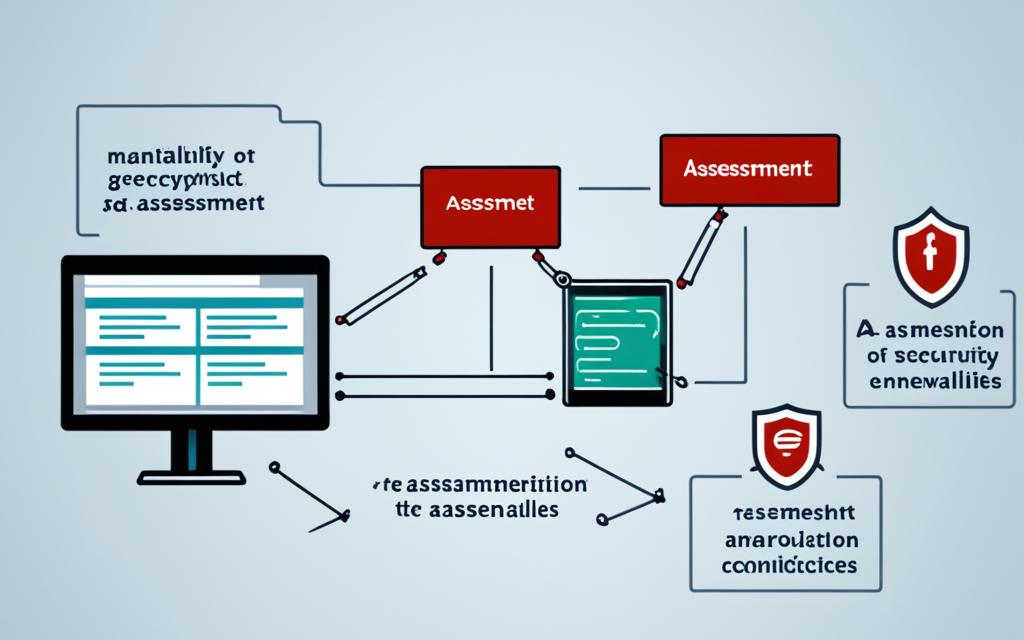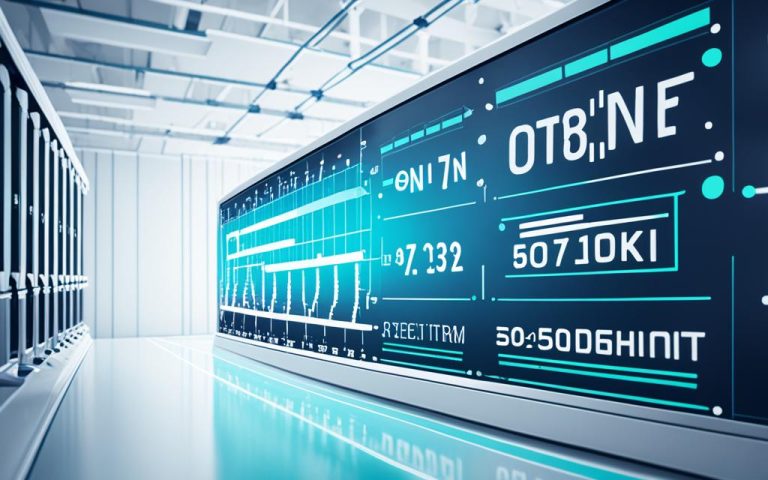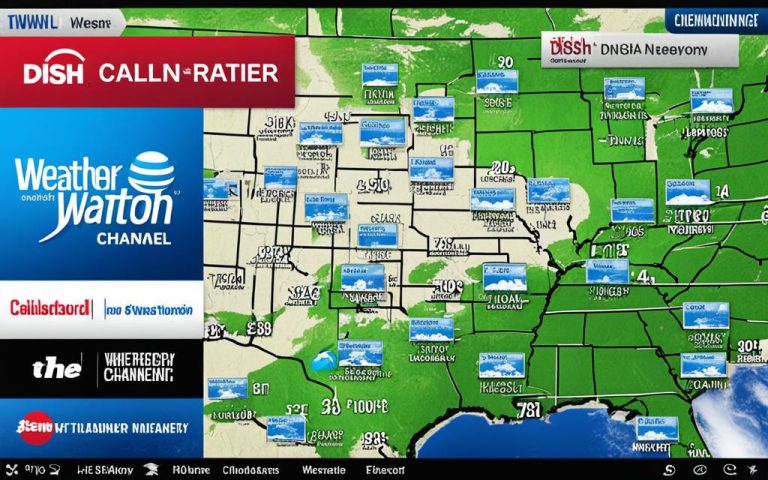A network security assessment is key to protecting your organization’s data. It helps reduce security risks and meet industry standards. By checking your network, you can spot weak spots and plan to keep your data safe.
There are two main types of checks: vulnerability assessments and penetration testing. Vulnerability assessments look at your network’s security from all angles. Penetration testing tests specific weaknesses found during the assessment.
Doing regular checks helps find and fix problems before hackers can. These assessments give you insights into where your network is weak. This lets you focus on fixing the most critical issues. Penetration tests give detailed info on your security level and suggest how to improve it.
Assessing your network security involves several steps. First, you gather info on your network setup. This helps set the scope and plan the assessment. A detailed list of important assets is also crucial to know what needs protection.
Spotting vulnerabilities is a big part of the assessment. Tools are used to scan for open ports, weak software, and unauthorized systems. These tools highlight risks that need quick action.
Writing down what you find is also key. This report lists security issues and risks. It helps you focus on the most serious problems. This makes it easier to make plans to fix these issues.
Improving security means putting in new controls. This could mean updating software or fixing network issues. By doing this, your network becomes stronger against threats.
Keeping an eye on your network is vital. Using tools to monitor for security issues helps catch problems early. This lets you act fast to protect against threats.
Key Takeaways:
- A network security assessment is crucial for safeguarding sensitive data, ensuring compliance, and reducing the risk of data breaches.
- Vulnerability assessments and penetration testing are the two main types of network security assessments.
- Gathering information, conducting an inventory, and assessing vulnerabilities are key steps in the network security assessment process.
- Implementing security controls and continuously monitoring the network are vital for maintaining network security.
- Organizations that conduct regular network security assessments experience a decrease in successful cyber attacks and demonstrate a commitment to client security.
What is a Network Security Assessment?
A network security assessment checks an organization’s IT setup, rules, and settings. It finds hidden weaknesses, checks risk levels, and offers steps to fix problems2. This helps companies spot cyber threats, find how attacks could hit, and protect important data2. It also helps follow rules and avoid big costs from data breaches.
These assessments use methods like checking for weaknesses and testing how secure a network is. They’re key to finding and fixing security gaps in a network2. Vulnerability checks spot issues like weak passwords and bad access controls2. Penetration testing tries to hack the network to find hidden weaknesses2.
Tools and methods are key for a full network security check. Tools like Nessus and OpenVAS help find and sort weaknesses by how serious they are3. Reports from these checks give an overview, technical details, and steps to fix problems3.
Penetration testing is a big part of checking network security. It goes through planning, scanning, getting in, staying in, and reporting3. Tools like Metasploit help find weaknesses and check how well security works3. Good practices include getting permission, using different tools, testing at quiet times, and keeping records3.
When checking network security, companies look at many areas. They check internal weaknesses, scan the network, review security policies, check on third parties, and list network devices4. This gives a clear view of risks and helps plan security4.
Network security checks are very important for companies that have to follow rules, like health care and credit card companies4. These checks help them meet rules and understand risks4. They are needed because of human mistakes, system failures, natural disasters, and attacks from others4.
Common Tools for Network Security Assessments
| Assessment Type | Tools |
|---|---|
| Vulnerability Assessment | Nessus, OpenVAS, QualysGuard, Retina, Nexpose |
| Penetration Testing | Metasploit, Nmap, Nessus, Burp Suite |
| Vulnerability Identification | Nmap, Metasploit, Wireshark, Netcat, Nikto |
Importance of Network Security Assessments
Network security assessments are key to keeping an organization’s data safe and secure. With cyber threats growing, it’s vital for companies to check their networks for weaknesses. This helps them strengthen their defenses.
According to statistical data5, there are two main types of network security assessments: vulnerability assessments and penetration tests. Vulnerability assessments find weak spots in a network. Penetration tests mimic real cyber attacks to test how secure a network is.
Many industries have rules for network security. For instance, credit card companies must follow the PCI DSS. Healthcare organizations need to meet HIPAA standards.
As per statistical data5, regular network security checks help organizations keep up with security standards. They also protect customer data and meet industry rules.
Network security assessments offer continuous monitoring through security ratings. These ratings show how well an organization is doing in security. They highlight areas that need work.
Statistical data5 shows that network security controls can be technical or non-technical. Technical controls include things like hardware and encryption. Non-technical controls are about security policies and physical barriers. These controls help prevent and detect attacks.
The process of assessing network security has several steps. First, you list what you have and value it. Then, you check for weaknesses and test your defenses. Finally, you document what you find in a report.
According to statistical data5, improving cybersecurity involves adding security controls like firewalls and encryption. Continuous monitoring is also key to staying ahead of threats.
When doing a network security check, consider all the risks. This includes natural disasters, system failures, and attacks from others.
In conclusion, network security assessments are crucial for protecting an organization’s data and reputation. By regularly checking their security and using the right controls, companies can stay ahead of cyber threats. This keeps customers trusting them.
Types of Network Security Assessments
Organizations need to be proactive in finding and fixing security gaps. Network security assessments are key in this effort. They come in two main forms: vulnerability assessment and penetration testing.
Vulnerability Assessment
Vulnerability assessment checks an organization’s network to find and sort security risks. It looks for weak passwords, bad encryption, and other security issues. This helps organizations strengthen their defenses and improve their security level6.
Using both automated tools and manual checks, these assessments spot weaknesses in networks and apps. This helps prevent security breaches. Plus, they’re often needed to meet industry and legal standards6.
Penetration Testing
Penetration testing is more than just checking for weaknesses. It pretends to be a real cyberattack to find hidden issues. This method tests how well an organization can defend against cyber threats.
This testing uses the same methods hackers do to find security holes. By doing this, organizations learn how to improve their defenses. They can see how an attack could affect their systems and plan better security strategies7.
There are different kinds of penetration tests, like network and application tests. Network tests check the security of the network itself. Application tests look at web apps and software for security risks. These tests help find and fix important security problems.
In summary, both vulnerability assessments and penetration testing are vital for good network security. Regular checks help find and fix security gaps. This keeps data safe and secure.
| Type | Description |
|---|---|
| Vulnerability Assessment | Involves identifying, classifying, and prioritizing vulnerabilities in an organization’s network |
| Penetration Testing | Simulates real-world cyberattacks to identify hidden vulnerabilities and weaknesses |
Process of Conducting a Network Security Assessment
Conducting a network security assessment is key to fighting cyber threats and keeping assets safe8. It’s a step-by-step process that checks and boosts the security of an organization’s network. By using detailed assessment methods, companies can spot weaknesses, check threats, and make sure their safety standards are up to par9.
1. Taking Inventory of Resources
The first step is to list all the network resources. This means looking at all the hardware, software, and data in the network9. It’s important to make sure everything important is counted. Then, sort these assets by how critical and sensitive they are to focus on what needs more attention8.
2. Determining Information Value
After listing resources, figure out how valuable the information is8. Know what data is most important and how it could affect the company if it gets out. This helps decide how to protect it10.
3. Assessing Vulnerabilities
Checking for weaknesses is a big part of the process9. Use tools and methods to find out where the network might be open to attacks8. This includes checking the network, finding internal issues, and looking at how data moves8. Knowing these weaknesses lets companies fix them before they’re a problem9.
4. Testing Defenses
Testing how well security measures work is also key9. This is done through penetration testing or ethical hacking, which pretends to be an attack to find weak spots9. Testing helps find and fix issues, making the network safer910.
5. Documenting Results and Implementing Security Controls
After assessing, write up the results and advice in a report8. This report shows what’s at risk and how to fix it8. Then, use this info to add better security steps to protect the network and its assets9.
6. Continuous Monitoring for New Issues
Security checks don’t stop after one assessment; they need to keep going10. Stay alert and check the network often to catch new threats10. Keeping up with new security tech and practices helps keep the network safe10.
This detailed process helps make networks more secure, keeps important assets safe, and fights cyber threats10. It helps companies deal with weaknesses, follow rules, and make a safe network for everyone.
Taking Inventory of Resources
The first step in checking network security is to list all resources and see what needs to be checked. This means finding out what networks, devices, data, and other assets are there. By sorting these assets by their value and what laws require, companies can focus their checks. This gives a clear picture of the network and its security controls11.
It’s key to know what sensitive data you have to figure out what’s most important to protect. This helps companies know which systems are most at risk and guides the checking process. By listing all networks, cloud systems, devices, and resources, companies get a full view of their setup12. They also see why it’s vital to sort data by its legal status, business importance, and value. This way, they can use their resources well and apply the right security steps12.
Looking into how business processes work is also crucial. By knowing the flow and links between important assets, companies can spot where they might be open to attack. This helps them focus their checks better and see how secure their network is13.
Reports from assessments should give a full picture of what was checked. They should talk about risks, how to exploit them, the value of these vulnerabilities, and how they could affect things. They should also suggest what steps to take to improve security. This way, companies can make smart choices to boost their network security13.
Overall, listing resources is a key step in a network security check. It helps companies know what to focus on, understand what’s most important, and put in place the right security measures. By documenting everything from networks to business processes, companies get a clear view of their setup. This, along with sorting data and understanding business flows, helps spot weak spots and support strong security plans121311.
Determining Information Value
When doing a network security check, figuring out the information value of assets is key. This means looking at how important different data and resources are. This helps organizations use their resources well and focus on security.
Creating a data classification policy helps set a standard for seeing how valuable assets are14. When deciding on the value of information, think about things like the financial or legal trouble from losing data. Also, consider how much the information is worth to competitors, if it can be made again, and its effect on money if lost. Lastly, think about how bad it would look if the data got out.
By putting assets into groups like critical, major, or minor, organizations can see what’s most important. This lets them focus on keeping safe the things that matter most. It also means they can still look after the less important data14.
A strong data classification policy also helps follow rules and standards, like the GDPR14. Following these rules is key to avoiding big fines. For example, Google had to pay $57 million in fines in France for not following GDPR14.
By knowing the value of information and classifying it, organizations can keep devices, networks, and important data safe from unauthorized access. This helps achieve the main goal of a network security check: keeping valuable assets safe and making sure data stays confidential, whole, and available14.
Getting data right and figuring out its value is key to a good network security assessment. This way, organizations can put their security efforts where they count the most. They can protect important assets and follow the law. By knowing what information is most important, they can use their resources well and keep their networks and data safe.
Assessing Vulnerabilities
Ensuring network security means checking for vulnerabilities to protect assets. By doing thorough vulnerability assessments, companies can spot and fix weak spots in their systems. This helps lower the chance of someone breaking into the network.
Vulnerability assessments look closely at security weaknesses in systems. They give companies insights into how secure their networks are15. These checks can stop threats like SQL injection, cross-site scripting (XSS), and other attacks1516.
The Importance of Network Scanning
Network scanning is key in vulnerability assessments. It helps find open ports, check network setups, and spot where attacks could happen. By scanning, security experts can deeply check the network and find any weak spots inside1517. They look at the security of devices, systems, and software on the network.
Network scanning also helps by finding devices on the network. This lets companies understand their network’s layout and find weak points17.
Reviewing Third-Party Access and Information Security Policies
Looking at security from the outside is also important. Companies should check how partners and vendors handle security. This helps spot risks and make sure the network is safe17.
Considering Various Threats and Risk Factors
Good vulnerability assessments cover many threats that could harm the network. These threats include natural disasters, system failures, human mistakes, and attacks from others. By thinking about all these risks, companies can focus their security efforts better1517.
Tools and Automation
Vulnerability assessment tools are crucial for finding weaknesses. They have special features for spotting problems. Tools like web scanners and network scanners make finding and analyzing vulnerabilities easier15. It’s smart for companies to do regular, automated checks on important systems1517.
Protective Measures: Imperva’s Web Application Firewall
To boost security, companies can use Imperva’s web application firewall (WAF). Imperva’s WAF shields against application weaknesses by blocking bad traffic. It also provides virtual fixes for vulnerabilities and detailed attack data. By working with SIEM platforms, Imperva’s WAF gives a clear view of threats and helps prepare for new attacks15.
Testing Defenses
After finding weak spots, it’s key to check how well an organization’s security works. This is done through penetration testing or ethical hacking. These methods mimic real cyberattacks to find and use hidden weaknesses. By testing systems, companies learn about their security level and how threats could affect them.
Penetration testing, or ethical hacking, is crucial for checking an organization’s defenses. It tests how strong an organization is against cyber threats. Skilled cybersecurity experts do this to find weak spots in networks, systems, and apps before bad actors can.
Penetration testing uses both manual and automated tools to give insights and advice on improving security. It mimics real attacks to find weaknesses and see how well an organization can handle them.
This testing is done with the company’s okay and helps them know their strong and weak points. It lets them take steps to make their network security defenses stronger.
Penetration testing helps organizations understand their weak spots and prepare for cyber threats. The findings help them fix security holes and get ready for new attacks.
Tools like Nessus, Qualys, Nmap, and Veracode are key in penetration testing. They find open ports, weak software, and other security issues. These tools help check if security measures are working well.
With new cyber threats always coming up, testing defenses often is a must. Regular network security assessments with penetration testing help keep data safe. This keeps an organization’s security up to date, follows industry rules, and builds trust with customers.
| Benefits of Testing Defenses | References |
|---|---|
| Enhanced protection against a wide range of cyber threats | 10 |
| Compliance with regulatory requirements | 10 |
| Improved security posture | 10 |
| Assurance of business continuity | 10 |
| Enhanced customer trust | 10 |
Documenting Results and Implementing Security Controls
After finishing the network security check, it’s key to write up the findings in a detailed network security assessment report18. This report gives a clear look at the weaknesses found and helps organizations boost their cybersecurity.
The network security assessment report should list each weakness, its risk level, possible attacks, value, chance of happening, and steps to fix it18. This info helps leaders decide where to spend money, set policies, and make procedures.
With the results in hand, companies can start adding security controls to make their cybersecurity stronger18. These controls can be tech-based or not, and they aim to fix the weaknesses found.
Technical controls like multi-factor authentication and encryption add more protection against unauthorized access and data theft18. Non-tech controls, like training employees, build a strong security culture in the company.
Network security assessments don’t just show how an attack could affect assets without actually happening18. They also give insights on how to protect against threats.
Types of Security Controls
| Type | Description |
|---|---|
| Technical Controls | Examples: Multi-factor authentication, encryption |
| Non-Technical Controls | Examples: Employee training, awareness programs |
Using both tech and non-tech security controls is key for a strong cybersecurity plan. These controls help prevent or catch security issues, lessen weaknesses, and lower the risk of cyber attacks18.
By writing up the results of a network security check and putting in the right security steps, companies can get better at security, cut down on breach risks, and keep their important stuff safe from cyber threats.
Continuous Monitoring for New Issues
The world of networks is always changing, making it key to keep a close watch on our security. Regular checks and using security ratings help us stay ahead. This way, we can keep our networks safe from cyber threats.
Security ratings give us clear info on how well we’re doing in keeping our data safe. They work alongside traditional ways of managing risks. This means we’re always on the lookout for new problems, like security mistakes or new threats.
More and more, our data is moving to the cloud. This makes keeping it safe a big challenge. With so much data in the cloud, we need to watch it closely to stop cyber attacks. In fact, 60% of our data is now in the cloud, making this issue even more critical19.
Laws like GDPR and CCPA push us to keep a close eye on our security. These laws help protect our customers’ data. By always checking our security, we make sure we meet these laws and keep our data safe2019.
Working with other companies can make us more vulnerable to attacks. Continuous monitoring helps us spot and fix these risks. This way, we can keep our networks safe from threats brought by others20.
Monitoring our security all the time has many benefits. It helps us understand our risks better and plan how to deal with them. It also gives us the tools to check our security and keep up with threats. This helps us protect our digital stuff and keep our businesses running smoothly20.
Using automated tools for monitoring is key to keeping our networks safe. These tools help us find security issues fast and deal with them quickly. They also save us time and money by making sure we follow the rules21.
Benefits of Continuous Monitoring for New Issues:
- Clear understanding of organizational risk tolerance
- Metrics for tracking security status
- Compliance verification
- Awareness of threats and vulnerabilities
- Reduced cybersecurity risks and impact of cyberattacks
- Improved response to security incidents
- Reduced data breach costs
- Efficient visibility into security and compliance posture
- Saved time and resources associated with compliance
Keeping a close watch on our security is key to spotting new problems early. It lets us catch security issues right away and alert our teams quickly. This way, we can tackle threats fast and keep our security strong19.
Training our employees is also crucial for a strong security culture. It helps them understand the importance of security and how to protect our data. This makes our defenses stronger against cyber threats19.
In conclusion, keeping a close watch on our security is essential. It helps us stay ahead of threats, find problems early, and follow the rules. By doing this, we can keep our networks safe and protect against new dangers.
Conclusion
Network security assessments are key to keeping an organization’s data safe. They check how secure a network is, make sure it meets the law, and lower the chance of data breaches. By using tools like Nessus and frameworks for testing, companies can spot and fix threats early2223.
Reports from security checks give deep insights into a company’s security level. They help security teams, auditors, and leaders make smart security choices. Following guidelines from NIST and the OWASP Testing Guide makes these reports more effective24.
Doing security checks often helps find new threats and weaknesses. Compliance checks see if controls are in place. Vulnerability checks show where security might be weak. Many laws now ask for yearly tests, and some companies use a “zero trust” method for better security23.
In short, checking network security is vital for keeping data safe and improving cybersecurity. Regular checks and reports help fix problems, follow the law, and make security stronger. Keeping up with new threats and tech is crucial for a strong defense against cyber attacks222423.
FAQ
What is a network security assessment?
A network security assessment checks an organization’s network for weaknesses. It finds risks and makes a plan to fix them.
Why is a network security assessment important?
It’s key for protecting data, following laws, and lowering the chance of data breaches.
What are the types of network security assessments?
There are two kinds: vulnerability assessment and penetration testing.
What is the process of conducting a network security assessment?
First, take stock of what you have. Then, figure out what’s valuable. Next, check for weaknesses and test how strong you are. After that, document what you find, put in security measures, and keep an eye out for new threats.
How do you take inventory of resources for a network security assessment?
You list all the networks, devices, data, and other assets that need checking.
How do you determine the value of assets for a network security assessment?
You use a data classification policy to decide how important an asset or piece of data is.
How do you assess vulnerabilities during a network security assessment?
You scan the network, look for internal weaknesses, do network scans, and check how others access your network and data.
How do you test defenses during a network security assessment?
You test defenses by simulating cyberattacks. This shows where you’re weak and what needs fixing.
How do you document results and implement security controls after a network security assessment?
You write up the findings in a detailed report. Then, use this to make decisions on security. Finally, put in new security steps to get better.
Why is continuous monitoring important in a network security assessment?
It helps find new weaknesses, tackle threats fast, and keep up with security rules and standards.
Why should organizations conduct regular network security assessments?
It helps deal with new threats, keep up with tech changes, and stay strong in security.
Source Links
- https://plextrac.com/network-security-assessment/ – What Is A Network Security Assessment? – PlexTrac
- https://www.rapidfiretools.com/blog/network-security-assessment/ – What is a Network Security Assessment? | RapidFire Tools
- https://startups.epam.com/blog/network-security-assessment – What Is Network Security Assessment | EPAM Startups & SMBs
- https://www.purpleguys.com/what-is-a-network-security-assessment/ – What Is a Network Security Assessment? | The Purple Guys
- https://www.upguard.com/blog/network-security-assessment – What is a Network Security Assessment? | UpGuard
- https://foresite.com/network-security-assessment-audit/ – Network Security Assessment & Audit | Foresite Cybersecurity
- https://cyberd.us/network-security-assessments – Network Security Assessments | Cyber Defense Institute
- https://www.algosec.com/blog/network-security-risk-assessment/ – How to Perform a Network Security Risk Assessment in 6 Steps | AlgoSec
- https://www.airdroid.com/security/network-security-assessment/ – Network Security Assessment Explanation & How-to Guide
- https://www.cloud9data.com/network-security-assessment/ – Network Security Assessment – The Ultimate Guide | Cloud9
- https://www.runzero.com/blog/asset-inventory-is-foundational/ – Asset inventory is foundational to security programs – runZero
- https://www.lightedge.com/blog/network-security-assessment-your-guide-to-a-complete-audit/ – Network Security Assessment: Your Guide to a Complete Audit
- https://cybersainik.com/how-to-perform-a-network-security-audit/ – How to Perform a Network Security Audit – 2024
- https://www.turn-keytechnologies.com/blog/article/what-is-a-network-security-assessment-and-why-do-you-need-one – What Is a Network Security Assessment (and Why Do You Need One)?
- https://www.imperva.com/learn/application-security/vulnerability-assessment/ – What is Vulnerability Assessment | VA Tools and Best Practices | Imperva
- https://www.synopsys.com/glossary/what-is-vulnerability-assessment.html – What Is a Vulnerability Assessment and How Does It Work? | Synopsys
- https://www.itarian.com/network-assessment/what-is-network-vulnerability-assessment.php – What is Vulnerability Assessment? | Network Vulnerability Testing
- https://panorays.com/blog/network-security-assessment-importance/ – What Is a Network Security Assessment and Why You Need It
- https://sprinto.com/blog/continuous-security-monitoring/ – What is Continuous Security Monitoring ? (CSM) – Sprinto
- https://www.upguard.com/blog/continuous-security-monitoring – What is Continuous Security Monitoring? | UpGuard
- https://secureframe.com/blog/continuous-monitoring-cybersecurity – 7 Benefits of Continuous Monitoring & How Automation Can Maximize Impact
- https://www.geeksforgeeks.org/what-is-network-security-testing/ – What is Network Security Testing? – GeeksforGeeks
- https://www.cbts.com/blog/what-is-a-security-assessment/ – What is a security assessment? | CBTS
- https://infosec-jobs.com/insights/security-assessment-report-explained/ – Security Assessment Report explained



















